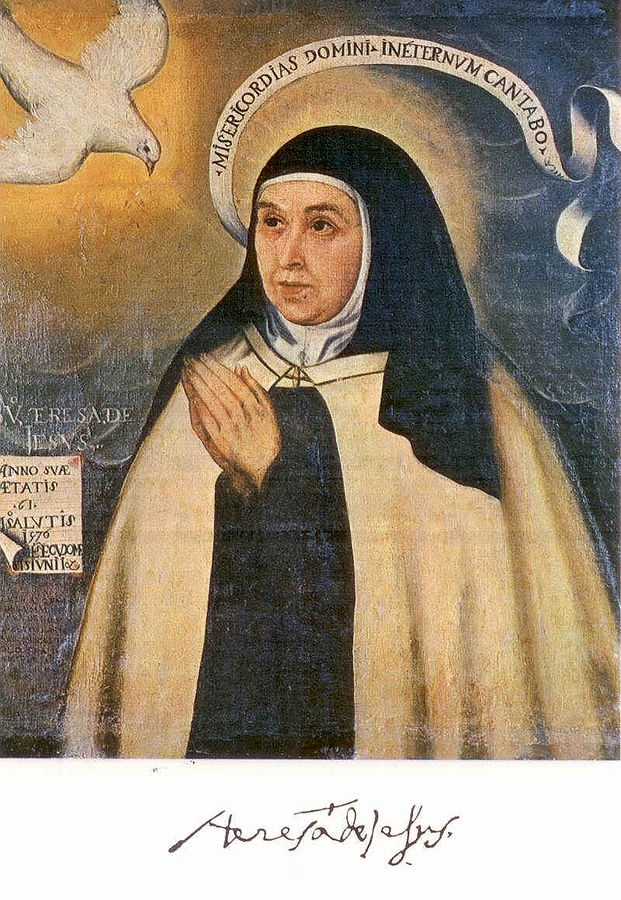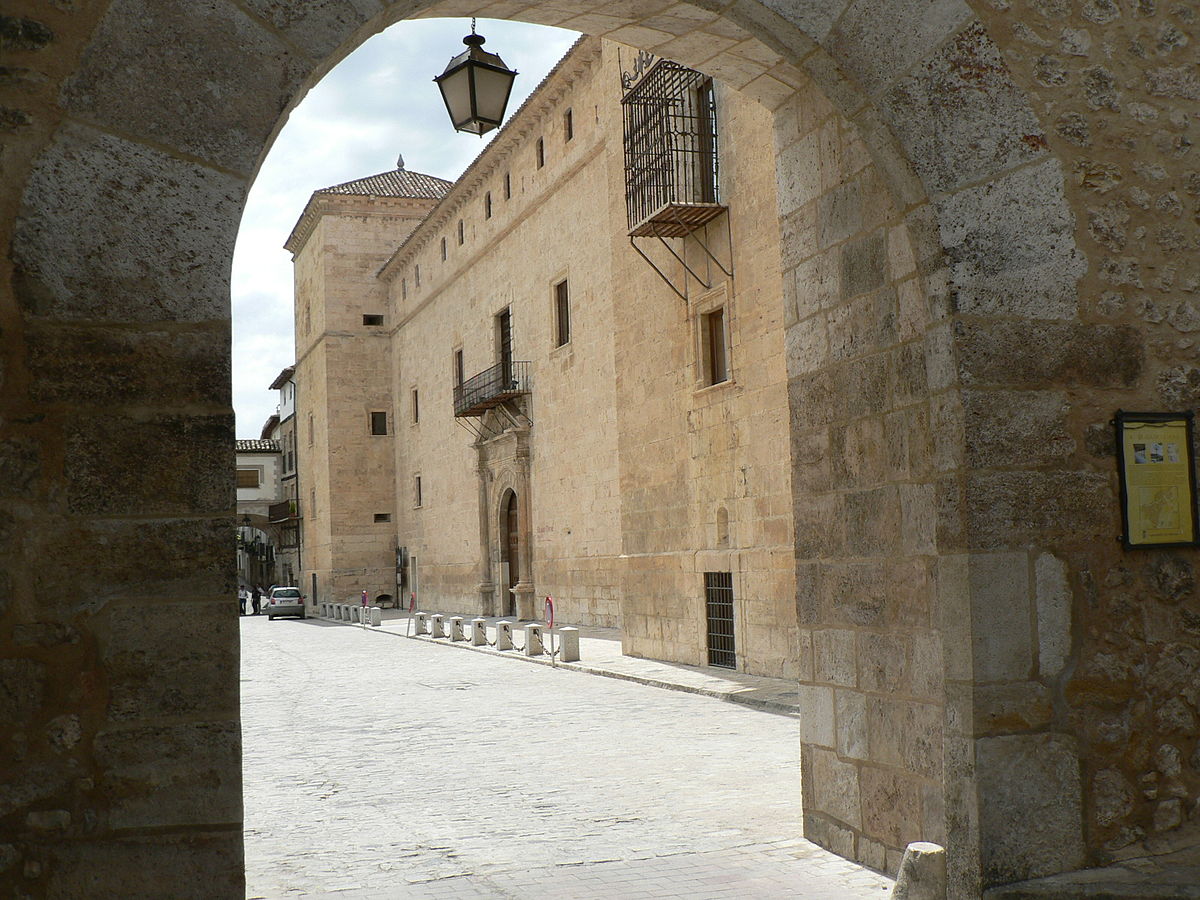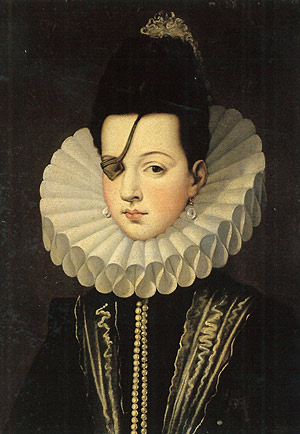The year 1569, and on a beautiful June afternoon, we shall see slowly entering Pastrana a covered wagon of the sort still called “galeras.” The mysterious vehicle excited much curiosity, and a crowd of men, women and children gathered round it when it stopped at the threshold of the ducal palace of Pastrana, whose heavy doors opened to receive it, leaving the curious outside. In the first courtyard Prince Ruy Gómez de Silva and his wife the Princess de Évoli were waiting with all their children, even down to the babies in the arms of their nurses and maids, the duennas, waiting-maids, pages and other retainers in rows, according to their standing. All eyes were fixed on the wagon, with curiosity mingled with respect, and those in the back row stood on tiptoe to see better. The curtains of the cart were at last withdrawn, and Ruy Gómez and his wife went forward respectfully; all heads were stretched out, and an old woman, who had been in the service of the Condesa del Mélito, the mother of the Princess, fell on her knees and beat upon her breasts. Three strange figures alighted, such as were never seen about the streets at that time; they wore tunics of coarse cloth, white cloaks of the same material, and their bare feet were shod with sandals of esparto grass; long, thick black veils covered their faces and almost all their persons. A small bundle tied up in a cloth was carried under the cloak by the last figure to alight.
All these marks of curiosity and respect, however, were well justified, as the woman who was first to get out, dressed in the coarse cloth, was St. Theresa de Jesus, who was come to found a convent of barefooted Carmelites at Pastrana. It was not two years since Ruy Gómez had come into possession of his duchy, and he was hastening to do all he could for the material and moral welfare of his vassals. He wished to establish a monastery in his town, and the Princess a convent for women, which she had given over to Mother Theresa, attracted by the wonderful things she had heard of this marvelous woman, and anxious to flatter her own curiosity and vanity by associating herself with one with whom God held familiar intercourse and to whom He showed such stupendous wonders. The saint accepted the offer; she was just beginning her great reforms, and for this purpose went from Toledo to Pastrana, passing by Madrid, where she stayed with an old friend of ours and a devoted follower of the saint, Doña Leonor Mascareñes, in the Franciscan convent which Doña Leonor had founded and to which she had retired.
 She gave Mother Theresa many details of the Princess’s difficult temper, having known her well at Court. Well primed with this information the saint went to Pastrana, where she arrived towards the end of June. Here, she says in her book about her foundations, “I found the Princess and the Prince Ruy Gómez, who received me very well; they gave me a private apartment, which was more than I could have expected, because the house was so small that the Princess had had much of it pulled down and rebuilt, not the walls, but many things. We were there for three months, hard times, the Princess asking me things contrary to our religion. I had even determined to leave rather than give in, but the Prince Ruy Gómez, in his gentle way (he was very gentle and sensible), made his wife come to reason.” Besides the troubles alluded to by the saint the Princess made others from her capricious, domineering character and want of fine feeling. She had heard that St. Theresa was very beautiful, in spite of being fifty-four, and she was dying of curiosity to see her face, but the saint would not consent to show it to her, nor did she or her companions ever lift their veils before the Princess or anybody else. This exasperated the Princess, and she was always peeping through the windows and keyhole hoping to surprise Theresa in one of her trances, in which Our Lord used to appear to her. Theresa laughed at what she calls stupidities, but in the end this constant prying worried and became intolerable to her.
She gave Mother Theresa many details of the Princess’s difficult temper, having known her well at Court. Well primed with this information the saint went to Pastrana, where she arrived towards the end of June. Here, she says in her book about her foundations, “I found the Princess and the Prince Ruy Gómez, who received me very well; they gave me a private apartment, which was more than I could have expected, because the house was so small that the Princess had had much of it pulled down and rebuilt, not the walls, but many things. We were there for three months, hard times, the Princess asking me things contrary to our religion. I had even determined to leave rather than give in, but the Prince Ruy Gómez, in his gentle way (he was very gentle and sensible), made his wife come to reason.” Besides the troubles alluded to by the saint the Princess made others from her capricious, domineering character and want of fine feeling. She had heard that St. Theresa was very beautiful, in spite of being fifty-four, and she was dying of curiosity to see her face, but the saint would not consent to show it to her, nor did she or her companions ever lift their veils before the Princess or anybody else. This exasperated the Princess, and she was always peeping through the windows and keyhole hoping to surprise Theresa in one of her trances, in which Our Lord used to appear to her. Theresa laughed at what she calls stupidities, but in the end this constant prying worried and became intolerable to her.
The Princess also gave her another real cause for annoyance; knowing that her confessor had ordered her to write her wonderful life, the Princess, full of curiosity, wished to read it. Mother Theresa refused with much firmness; this piqued the capricious lady, who wrote to the saint’s superiors, asking them to order her to let the Princess read the manuscript she had with her at Pastrana. They, being either very complacent or not knowing the Princess’s character, did not hesitate to give the order. Theresa obeyed without delay, and then the Princess triumphed. She greedily read the ingenuous pages in which the divine marvels are told with such sublime simplicity; they excited her imagination, and, like all talkative women, feeling the necessity of imparting her feelings, she committed the breach of confidence of giving the manuscript to her duennas, waiting-maids and pages. So from hand to hand, in hall and antechamber, went the mysterious outpouring of the Virgen del Carmel, and so many comments were made that they reached the ears of the Inquisitor, who sent for the book. The severe tribunal kept it for ten years and then returned it without observation or alteration, but not before all this had caused very great annoyance.
At last the foundation was finished, and Mother Theresa left for Salamanca and the Prince and Princess for Madrid, where a year afterwards Ruy Gómez died in his house in the lane of St. Mary. He expired in the arms of his old and faithful friend Juan de Escovedo; his last moments were aided by two barefooted Carmelite friars who came from Pastrana.
Rev. Fr. Luis Coloma, The Story of Don John of Austria, trans. Lady Moreton, (New York: John Lane Company, 1912), Book IV, Ch. XVII, pp. 382 – 385.
Short Stories on Honor, Chivalry, and the World of Nobility—no. 695













